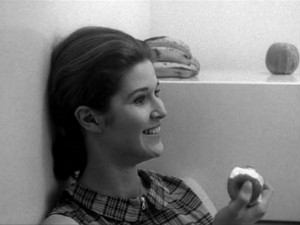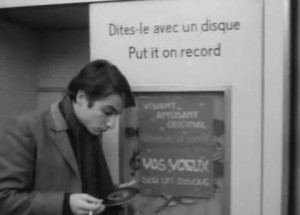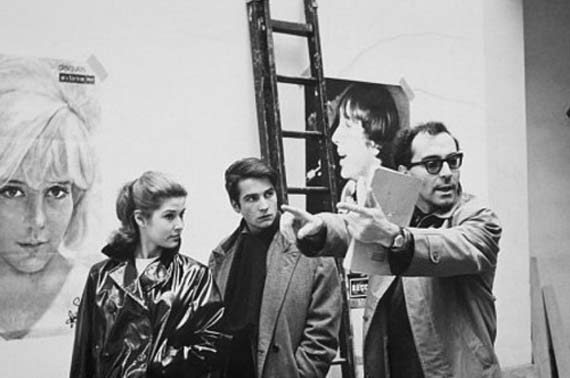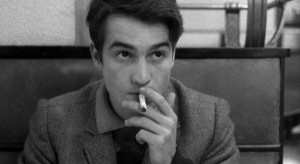The Sound of Marx and Coca-Cola: The Aural Aesthetics of Jean-Luc Godard’s Masculin Féminin
BANG! … BANG! … Before revealing any actual footage of Masculin Féminin, Godard jolts the viewer with two sharp gunshots. Message to the audience: If you’re here to relax and escape, you’re watching the wrong film. Much has been written about the heavily influential French New Wave movement, yet most analysis of the aesthetic decisions has focused on the visuals. This is with good reason since, even on mute, most films of the Nouvelle Vague era are instantly recognizable. Surely, however, in films as bold as these, distinct sonic decisions have been made. It’s hard to think of a better example than Godard’s 1966 classic Masculin Féminin.
The Americans are good at storytelling. The French are not. Flaubert and Proust can’t tell stories. They do something else. So does cinema …1
This Godard quote should alienate most sound designers in the sense that, for many, their entire purpose is to use their finely honed skills to subtly enhance the story. After capturing clear as possible production sound, most sound teams go to painful lengths to perfect each line of dialogue, capture each footstep, and add bits of barely noticeable, but effective, abstract sound design.
In Masculin Féminin, there is little to none of this. This does not mean, however, that Godard does not make use of sound. Quite the opposite, in fact. In this film, Godard takes tremendous advantage of the soundscape to express his notions of filmmaking, as well as his interpretation of society, particularly that of the 1960s youth culture of France. Nearly everything about Masculin Féminin is raw ― from the visuals to the audio, from the script to the acting. For contemporary viewers who are not as familiar with the chronology of film history, it’s easy to look at Masculin Féminin and be unaware of just how intentionally raw it was. In 1966, there were still many films being produced in black and white and mono, but even Godard himself had directed films in color by then, including Pierrot Le Fou (1965) and Contempt (1963), both of which have much less abrasive soundtracks.
Not only is there no attempt, other than the jarring gunshot sound effect, to add to or “sweeten” Masculin Féminin sonically, there is a refusal to provide the audience with a clean, intelligible listening experience. The soundtrack of the film, littered with all sorts of noise, was, without a doubt, a conscious decision. Immediately noticeable in the first scene of the film is the clamour-filled production audio within a Parisian café in which the two main characters, Paul (played by Jean-Pierre Léaud) and Madeline (played by Chantal Goya), interact for the first time. Unlike some European films of the time, the lines were not recorded after the fact.2 The audio that exists in this film was clearly recorded on set. Since the dialogue miking can be considered casual at best, the character’s lines are forced to contend with the café noise, street traffic, and even the reflection of the actors’ own voices off the hard floor and coffee cups. At one point, a customer walks in and leaves the door open, which forces Paul to exclaim “La porte!” as if to say, “Shut the door! It’s hard enough to hear what this girl is saying as it is.”
The abrasive production audio, similar to many an early student film, recorded with a single low-end mic attached to the camera, remains throughout the entire film. The only time the audience is spared is during the scenes with no sound at all or in those that contain only a voice-over track (which, even though it was presumably recorded in post, has the quality of a Dictaphone in a bathroom). What makes the film even bolder is the fact that there is no attempt to provide the listener with smooth transitions between the noisy production audio and the silent scenes. Much of the time, audio tracks simply hard cut from one to the other, without the courtesy of even the smallest fade in or out. Although this is often dictated by the picture edit, there are more than a few scenes where the shot remains the same and the sound jumps ship. If you know everything you’re going to do beforehand, it isn’t worth doing. 3 It is well-known that Godard, especially with this film, was influenced by the cinéma vérité movement in France.4 Masculin Féminin was to represent the real youth culture of urban Paris, not some make-believe film. This explains the hand-held camera work and the improvised dialogue, which included many interrogation-style scenes, where a “conversation” is taking place between two characters but the camera remains focused on the one answering the questions. In these scenes, the microphone is always aimed at the person on camera, even when the other character speaks, making the off-screen lines much more difficult to hear.

In the bathroom scene, when Paul and Madeline actually begin opening up to each other, the camera cuts between the two about every 30 to 40 seconds—pretty slow in movie-time. Also, in most films, the sound would be edited so that the audience always hears a miked recording of the character who is speaking, even if that character is off-screen. This might be considered sound “trickery,” but it’s standard procedure and is subconsciously expected by most audiences. Scenes like this one are proof that there was little to no editing done, sound-wise, to improve the audio quality of the film. Rather than engage in “trickery,” Godard chooses to confront the audience with its own expectations.
The improvised dialogue of Godard was an aspect of his films that very likely influenced later directors such as Robert Altman.5 The difference between Godard and someone like Altman is that Altman’s films are much closer to orchestrated chaos, as if the “noise” factors that could disrupt the flow of the film were put in place to do so, even if the exact timing could not be predicted. Godard, on the other hand, in Masculin Féminin in particular, lets a real-world aural atmosphere do its work. Therefore, the sound in his scenes is much less predictable than Altman’s. Both directors allowed such scenes to run on for extended periods of time, increasing the chance for random sonic intrusion. If we, movie people, want to be called artists, we must remember and respect this rule: Any true moral standards imply a fierce resistance to tyranny.6 Even the musical interludes in Masculin Féminin, which are few and far between, are anything but a relief from the abrasiveness of the rest of the soundscape. First of all, there is no score. The only songs that make up the music soundtrack are a handful of rock ‘n’ roll pop songs sung by lead actress Chantal Goya, who was both a real-life French yé-yé/pop singer and an up-and-coming pop singer in the film. While the songs are catchy and well-suited to the youth culture Godard is attempting to portray, they are hardly polished recordings. On top of that, no song is played from start to finish. The ones that do come in are often abruptly cut off after 10 to 20 seconds. One example of this occurs when Goya’s Tu M’as Trop Menti begins to play as Paul walks up to a man playing pinball at the arcade. The man proceeds to pull out a knife and wield it at Paul. Simultaneously, the song is yanked from the film, mid-verse. Just when the audience thinks they’re getting a poppy musical interlude, they get a knife pulled on them. Only when the man decides to stab himself instead of Paul does the music eventually kick back in.

A scene that combines both improvised dialogue and obtuse use of music is one between two supporting characters: Madeline’s roommate, Catherine, and Paul’s friend Robert, who is attempting to court her. The scene, which switches between shots of the two for nearly 7 minutes (long enough for Catherine to eat an entire apple), is one of the more awkward interactions in the film. Similar to the bathroom scene between Paul and Madeline, the off-camera voice is always off-mic, except this time there is a Goya song playing over the top for much of the back and forth. This pop tune, however, fades in and out in such an arbitrary manner that the viewer is never quite able to sink into its groove. It almost feels like the song level is being controlled by a child handling a volume knob for the first time, which in a way is similar to the disjointed flow of the conversation between these two young adults, who are struggling to express themselves to each other.
There are times when you don’t necessarily need a baby, but it happens you have one anyway … it would perhaps be better had it come along at another time, but when it’s there you dress it in whatever’s at hand. 7
It would be easy to say that because Godard was unable to provide decent sound (or to improve it after the fact), and because the music levels are wild and unpredictable, sound was simply not a priority of his. But this might imply that he was unaware of exactly how this sonic ignorance would affect his film. If that were the case, however, Masculin Féminin would not be as effective as it is, and Godard himself would not be such a hard act to mimic. Anyone can decide that they’d rather throw paint at a canvas than use a brush, but not everyone is Jackson Pollock. There’s an old saying that in order to correctly break the rules, one must first learn them. Both Godard and Truffaut were avid film enthusiasts and critics, having written for Cahiers du Cinéma years before breaking to into the medium themselves.8 Godard, in his own clever way, reminds the viewers of this when, in Masculin Féminin, Paul, twice while attending the cinema, storms up to the projection room to complain that the film is not being displayed with the correct aperture. If Paul represents Godard, then the aged projectionist whom he is scolding represents the withered film industry of the time. If so, this is Godard’s way of making it clear that he knows the rules better than those who enforce them, and so this allows him to take such liberties in his own films. While this scene specifically references the visual side of things, Godard, as a cinephile, surely was aware of how his soundtrack came off.

In fact, there is another clever scene slipped into Masculin Féminin, in which Paul, who is meandering around the local arcade, wanders into something that looks similar to a photo booth but is actually a recording booth. “Dites-le avec un disque,” it says atop the entrance (with the English translation, “Put it on record,” painted underneath). Here, Paul inserts 2 francs into the coin slot and proceeds to ramble out a minute-long soliloquy. Immediately after, the booth spits out a 7-inch vinyl record, which Paul nonchalantly slips into his pocket as he returns to his cigarette. It’s hard to say exactly what Godard’s intent was with this scene (he could have had several), but it’s also difficult not to observe the correlation between the utterly unprofessional “studio” where Paul makes his recording and the film’s seemingly amateurish soundtrack. I think it was Baudelaire who said that it was on toilet walls that you see the human soul; you see graffiti there ― politics and sex. 9 The anti-Vietnam war sentiments expressed by the youthful characters in the film are juxtaposed with their affinity for popular culture.
In a way, both themes can be linked back to the sound effect of the gunshot, which is not only played in the opening credits, but repeated throughout the film during the intertitles between scenes. While the link between a gun firing and the violence in Vietnam is not much of a leap, what might be more interesting is the fact that the gunshot is literally the same repeated sound effect, over and over. While typically the use of a repeated sound effect could be attributed to lazy sound design, it’s safe to say that Godard made the choice not to use varying gunshots. Perhaps, just perhaps, it could be interpreted as representative of the then (and now) culture of assembly line mass production. Just as the youth enjoys the same, identical can of Coca-Cola, so does this film in its use of a repeated “canned” sound effect.
So, again, what makes this film fascinating from a sound design point of view is that most of those in the field of film-sound spend their waking hours trying to make their work unnoticed. They strive for clean dialogue and apply smooth transitions between shots, as well as between the film audio and the music. They also vary their sound effects so as not to draw attention to the fact that they added them in post-production. So, in many ways, Godard’s choice of sound design could be considered an affront to the aural aspect of professional filmmaking. Ultimately, it leads back to the question: What exactly was Godard was trying to accomplish in the first place? It has been said that Godard never wanted his audience to forget that they were watching a film.10 There could be several reasons for this, from lingering memories of censorship and propaganda during Nazi-occupied France to simply opposition to the fantasy-filled Hollywood style of filmmaking.11 Either way, Godard attempted to achieve this in every aspect of Masculin Féminin, which includes both the audio and the visuals. What’s interesting is that arguably, nearly half a century later, the visuals have become more aesthetically charming, while the audio has remained jarring and obtrusive. In this way perhaps it was through sound that Godard was most lastingly effective in what he originally set out to accomplish, which, no doubt, is more than most films can claim.
Posted on May 28, 2012
1. Louis Giannetti. Understanding Movies (New York: Simon & Schuster, 1996), 322.
2. Brian Henderson & Ann Martin. Film Quarterly, Forty Years ― A Selection (Berkeley: University of California Press, 1999), 350.
3. Louis Giannetti. Understanding Movies (New York: Simon & Schuster, 1996), 322.
4. András Bálint Kovács. Screening modernism: European art cinema, 1950-1980 (Chicago: The University of Chicago Press, 2007), 170.
5. Rick Altman. Sound Theory, Sound Practice (London: Routledge, 1992), 110.
6. Two in the Wave. Dir. Emmanuel Laurent. Prod. Films à Trois, 2010. DVD.
7. Phillipe Labro. “One Evening, in a Small Café.” La Nouvea Candide. 17 Jan, 1966.
8. Two in the Wave. Dir. Emmanuel Laurent. Prod. Films à Trois, 2010. DVD.
9. Phillipe Labro. “One Evening, in a Small Café.”
10. David Bordwell. Narration in the fiction film (The University of Wisconsin Press, 1985), 326.
11. Richard John Neupert. A History of the French New Wave Cinema (The University of Wisconsin Press, 2007), 64.


